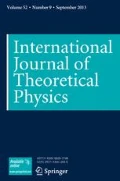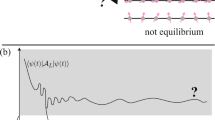Abstract
Work done before on the construction of quantum mechanical Hamiltonian models of Turing machines and general discrete processes is extended here to include processes which erase their own histories. The models consist of three phases: the forward process phase in which a mapT is iterated and a history of iterations is generated, a copy phase, which is activated if and only ifT reaches a fix point, and an erase phase, which erases the iteration history, undoes the iterations ofT, and recovers the initial state except for the copy system. A ballast system is used to stop the evolution at the desired state. The general model so constructed is applied to Turing machines. The main changes are that the system undergoing the evolution corresponding toT iterations becomes three systems corresponding to the internal machine, the computation tape, and computation head. Also the copy phase becomes more complex since it is desired that this correspond also to a copying Turing machine.
Similar content being viewed by others
References
Bell, J. S. (1975).Helvetica Physica Acta,48, 93.
Benioff, P. (1980).Journal of Statistical Physics,22, 563.
Benioff, P. (1981).Journal of Mathematical Physics,22, 495.
Bennett, C. H. (1973).IBM Journal of Research and Development,17, 525.
Davis, M. (1958).Computability and Unsolvability. McGraw-Hill, New York.
Hepp, K. (1972).Helvetica Physica Acta,45, 237.
Keyes, R. W., and Landauer, R. (1970).IBM Journal of Research and Development,14, 152.
Landauer, R. (1976).Berichte der Bunsengesellschaft für Physikalische Chemie.,80, 1048.
Landauer, R. and Woo, J. W. F. (1971).Journal of Applied Physics,42, 2301.
Newton, R. (1966).Scattering Theory of Waves and Particles, Chapter 18. McGraw-Hill, New York.
Schiff, L. (1968).Quantum Mechanics, 3rd ed., pp. 339–341. McGraw-Hill, New York.
Sz Nagy, B. and Foias, C. (1970).Harmonic Analysis of Operators on Hilbert Space, Chapter 1. North-Holland American Elsevier, New York.
Von Neuman, J. (1955).Mathematical Foundations of Quantum Mechanics, trans. R. T. Beyer, Chapter 3. Princeton University Press, Princeton, New Jersey.
Author information
Authors and Affiliations
Rights and permissions
About this article
Cite this article
Benioff, P.A. Quantum mechanical Hamiltonian models of discrete processes that erase their own histories: Application to Turing machines. Int J Theor Phys 21, 177–201 (1982). https://doi.org/10.1007/BF01857725
Received:
Issue Date:
DOI: https://doi.org/10.1007/BF01857725




